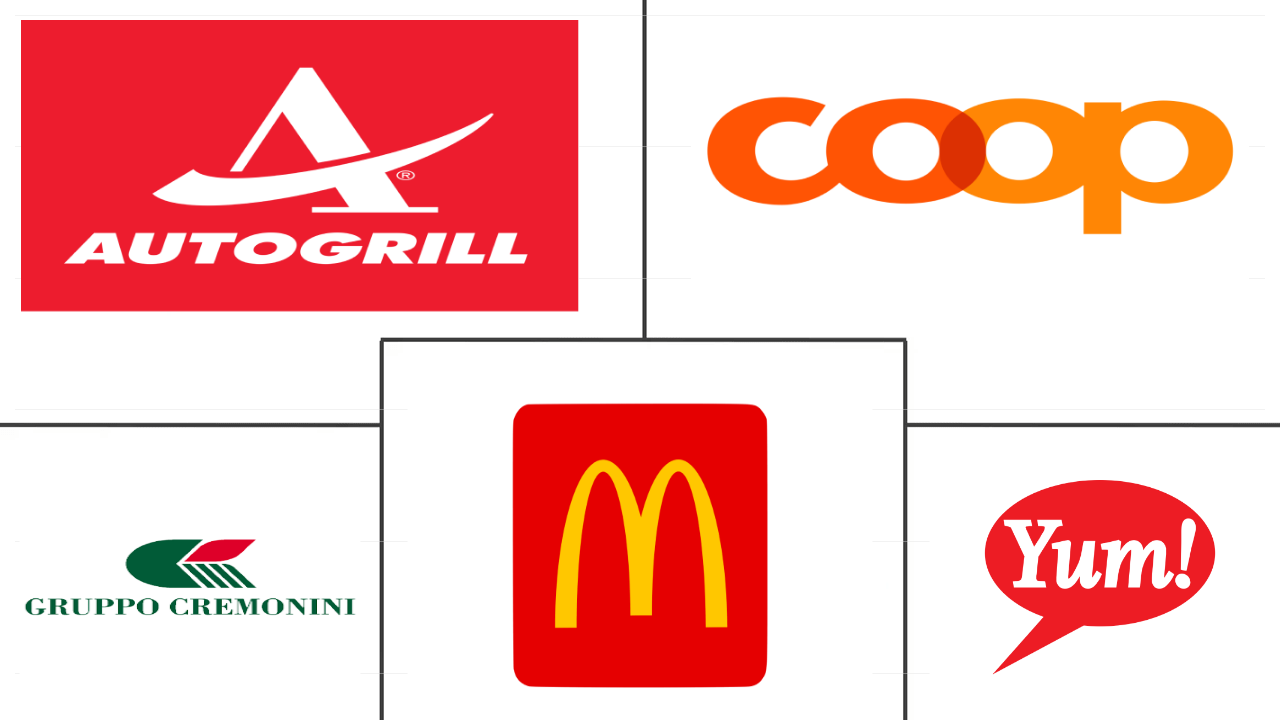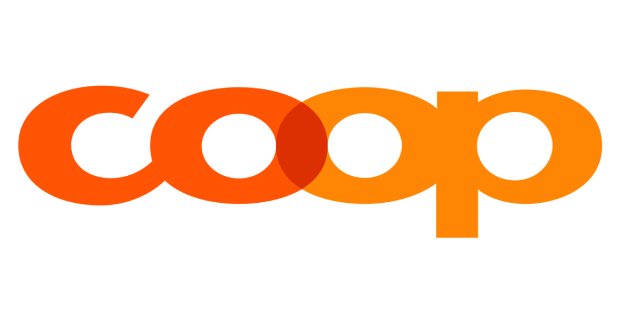Market Size of europe foodservice Industry
| Icons | Lable | Value |
|---|---|---|
|
|
Study Period | 2017 - 2029 |
|
|
Market Size (2024) | USD 0.87 Trillion |
|
|
Market Size (2029) | USD 1.36 Trillion |
|
|
Largest Share by Foodservice Type | Full Service Restaurants |
|
|
CAGR (2024 - 2029) | 9.34 % |
|
|
Largest Share by Country | Germany |
|
|
Market Concentration | Low |
Major Players |
||

|
||
|
*Disclaimer: Major Players sorted in no particular order |
Europe Foodservice Market Analysis
The Europe Foodservice Market size is estimated at 0.87 trillion USD in 2024, and is expected to reach 1.36 trillion USD by 2029, growing at a CAGR of 9.34% during the forecast period (2024-2029).
0.87 Trillion
Market Size in 2024 (USD)
1.36 Trillion
Market Size in 2029 (USD)
5.63 %
CAGR (2017-2023)
9.34 %
CAGR (2024-2029)
Largest Country
15.84 %
value share, Germany, 2023
Increasing popularity of German cuisine and culture among locals and tourists, with a growth in international business and tourism, along with several investments in new and emerging opportunities are anticipated to drive the growth of the German market
Fastest-growing Country
16.09 %
Projected CAGR, Netherlands, 2024-2029
Consumer inclination toward multi-cuisines and the preference for unique dining experiences and ambiance of restaurants are boosting the demand for independent outlets in the Netherlands.
Largest Segment by Foodservice Type
37.09 %
value share, Full Service Restaurants, 2023
Asian and European cuisines led to the growth of full service restaurants, with the two segments accounting for a 71% value share of total full service restaurants in 2022.
Fastest-growing segment by Foodservice Type
17.09 %
Projected CAGR, Cloud Kitchen, 2024-2029
Increasing demand for food delivery services and the changing consumer preferences toward online ordering with many food delivery companies are driving the segment's growth.
Leading Market Player
0.54 %
market share, Coop Gruppe Genossenschaft, 2022

It is the largest market player as it is one of the major operators in onboard train catering, managing 140 trains daily in five European countries.
Increased investments through venture capital resulted in significant potential for cloud kitchens in the region
- The European foodservice industry is primarily dominated by full service restaurants (FSR), followed by Cafes & Bars. The market is driven by several factors, including the growth of the online food delivery market, increased tourism, and a rising immigrant population in the region. Online food delivery has emerged as a significant player in the restaurant business, with substantial investments from venture capital funding. In 2020, European food tech start-ups received a total investment of USD 2.95 billion, representing a growth of over 94% since 2015 and a staggering 1,200% since 2013. Key players in this market include Deliveroo, Just Eat, Uber Eats, GrubHub, and Glovo.
- The full service restaurant segment in Switzerland experienced a CAGR of 1.45% by value during the study period, attributed to increased disposable income and the rising tourism in the region. In 2021, the median disposable income in the European Union was 18,019 PPS (purchasing power standard) per inhabitant.
- Cloud kitchens are anticipated to be the fastest-growing segment in the foodservice industry, with a projected CAGR of 17.39% in terms of value during the forecast period. The surge in internet usage has encouraged people to order food online due to the multitude of options available through the expansion of start-up companies and chained cloud kitchens across the region. In Northern Europe, the average order value for online food delivery grew by 17% from 2019 to 2022, increasing from USD 23.53 to USD 27.54. Similarly, Southern Europe saw a 14.85% increase in average order value during the same period, rising from USD 22.22 to USD 25.52.
The rising number of immigrants from Asian countries propelling the demand for Asian cuisine in Germany
- Germany held the major share of the food service market in Europe in 2022. The German food service sector is being driven by full-service restaurants and quick-service restaurants in the country. This is attributed to the increasing number of immigrants from Asian countries. As of 2021, there were over 2.8 million people with an Asian background living in Germany. Immigrants from Asia represent one of the largest groups in Germany, making up approximately 22% of the total immigrant population. This has created a demand for Asian cuisine among both locals and tourist visitors. Moreover, As of 2022, there were 1,432 outlets of Mcdonalds' and 750 Burger King outlets in Germany. The presence of major fast-food chains across the country is further propelling market growth.
- Western European food service markets have seen significant growth over the years, primarily due to the growth of the online food delivery market in the region. The market has been clustered with various smartphone applications focused on food delivery. For instance, in France, there were 15 food delivery applications with more than 120,000 downloads, and these applications collectively had more than 10.3 million downloads in 2022.
- The Dutch food service market is anticipated to grow the fastest and is projected to record a CAGR of 16.24% by value during the forecast period. The growth will be driven by the incoming tourism in the country. The influx of people coming from countries like China, Japan, and India to the Netherlands has led to the growth of full-service restaurants, especially Asian cuisine. As of February 2022, there were around 800 Chinese restaurants in the Netherlands ranging from takeaway to high-end eat-in-a-floating restaurant kind of places.
Europe Foodservice Industry Segmentation
Cafes & Bars, Cloud Kitchen, Full Service Restaurants, Quick Service Restaurants are covered as segments by Foodservice Type. Chained Outlets, Independent Outlets are covered as segments by Outlet. Leisure, Lodging, Retail, Standalone, Travel are covered as segments by Location. France, Germany, Italy, Netherlands, Russia, Spain, Switzerland, Turkey, United Kingdom are covered as segments by Country.
- The European foodservice industry is primarily dominated by full service restaurants (FSR), followed by Cafes & Bars. The market is driven by several factors, including the growth of the online food delivery market, increased tourism, and a rising immigrant population in the region. Online food delivery has emerged as a significant player in the restaurant business, with substantial investments from venture capital funding. In 2020, European food tech start-ups received a total investment of USD 2.95 billion, representing a growth of over 94% since 2015 and a staggering 1,200% since 2013. Key players in this market include Deliveroo, Just Eat, Uber Eats, GrubHub, and Glovo.
- The full service restaurant segment in Switzerland experienced a CAGR of 1.45% by value during the study period, attributed to increased disposable income and the rising tourism in the region. In 2021, the median disposable income in the European Union was 18,019 PPS (purchasing power standard) per inhabitant.
- Cloud kitchens are anticipated to be the fastest-growing segment in the foodservice industry, with a projected CAGR of 17.39% in terms of value during the forecast period. The surge in internet usage has encouraged people to order food online due to the multitude of options available through the expansion of start-up companies and chained cloud kitchens across the region. In Northern Europe, the average order value for online food delivery grew by 17% from 2019 to 2022, increasing from USD 23.53 to USD 27.54. Similarly, Southern Europe saw a 14.85% increase in average order value during the same period, rising from USD 22.22 to USD 25.52.
| Foodservice Type | ||||||||||
| ||||||||||
| Cloud Kitchen | ||||||||||
| ||||||||||
|
| Outlet | |
| Chained Outlets | |
| Independent Outlets |
| Location | |
| Leisure | |
| Lodging | |
| Retail | |
| Standalone | |
| Travel |
| Country | |
| France | |
| Germany | |
| Italy | |
| Netherlands | |
| Russia | |
| Spain | |
| Switzerland | |
| Turkey | |
| United Kingdom | |
| Rest of Europe |
Europe Foodservice Market Size Summary
The European foodservice market is experiencing robust growth, driven by the increasing popularity of full-service restaurants and cafes, alongside a significant rise in online food delivery services. The market is characterized by a diverse range of dining options, with full-service restaurants leading the charge, followed by cafes and bars. The surge in online food delivery has been a game-changer, with substantial investments fueling the expansion of food tech startups and cloud kitchens. This trend is further supported by the rise in tourism and a growing immigrant population, particularly in countries like Germany and the Netherlands, which has spurred demand for diverse cuisines. The market is also witnessing a shift towards convenience, with quick-service restaurants and cloud kitchens gaining traction due to their ability to cater to the fast-paced lifestyles of consumers.
In terms of market dynamics, Germany holds a significant share, driven by the presence of major fast-food chains and a burgeoning demand for Asian cuisine. The Dutch market is poised for rapid growth, fueled by incoming tourism and a thriving restaurant scene. Meanwhile, Turkey's foodservice sector is dominated by cafes and bars, with a notable increase in quick-service restaurants. The French market stands out with its high average order value in full-service restaurants, reflecting a strong consumer preference for local and unique dining experiences. The fragmented nature of the market sees major players like McDonald's, Yum! Brands, and Autogrill SpA competing for market share, while emerging trends such as cloud kitchens and online delivery platforms continue to reshape the landscape.
Europe Foodservice Market Size - Table of Contents
-
1. MARKET SEGMENTATION (includes market size in Value in USD, Forecasts up to 2029 and analysis of growth prospects)
-
1.1 Foodservice Type
-
1.1.1 Cafes & Bars
-
1.1.1.1 By Cuisine
-
1.1.1.1.1 Bars & Pubs
-
1.1.1.1.2 Cafes
-
1.1.1.1.3 Juice/Smoothie/Desserts Bars
-
1.1.1.1.4 Specialist Coffee & Tea Shops
-
-
-
1.1.2 Cloud Kitchen
-
1.1.3 Full Service Restaurants
-
1.1.3.1 By Cuisine
-
1.1.3.1.1 Asian
-
1.1.3.1.2 European
-
1.1.3.1.3 Latin American
-
1.1.3.1.4 Middle Eastern
-
1.1.3.1.5 North American
-
1.1.3.1.6 Other FSR Cuisines
-
-
-
1.1.4 Quick Service Restaurants
-
1.1.4.1 By Cuisine
-
1.1.4.1.1 Bakeries
-
1.1.4.1.2 Burger
-
1.1.4.1.3 Ice Cream
-
1.1.4.1.4 Meat-based Cuisines
-
1.1.4.1.5 Pizza
-
1.1.4.1.6 Other QSR Cuisines
-
-
-
-
1.2 Outlet
-
1.2.1 Chained Outlets
-
1.2.2 Independent Outlets
-
-
1.3 Location
-
1.3.1 Leisure
-
1.3.2 Lodging
-
1.3.3 Retail
-
1.3.4 Standalone
-
1.3.5 Travel
-
-
1.4 Country
-
1.4.1 France
-
1.4.2 Germany
-
1.4.3 Italy
-
1.4.4 Netherlands
-
1.4.5 Russia
-
1.4.6 Spain
-
1.4.7 Switzerland
-
1.4.8 Turkey
-
1.4.9 United Kingdom
-
1.4.10 Rest of Europe
-
-
Europe Foodservice Market Size FAQs
How big is the Europe Foodservice Market?
The Europe Foodservice Market size is expected to reach USD 869.45 billion in 2024 and grow at a CAGR of 9.34% to reach USD 1358.52 billion by 2029.
What is the current Europe Foodservice Market size?
In 2024, the Europe Foodservice Market size is expected to reach USD 869.45 billion.

